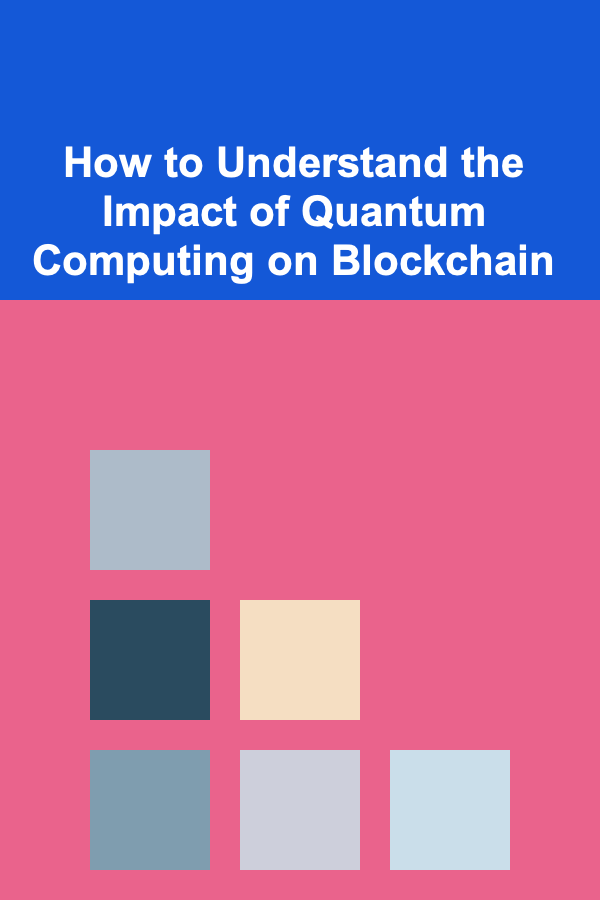
How to Understand the Impact of Quantum Computing on Blockchain
ebook include PDF & Audio bundle (Micro Guide)
$12.99$11.99
Limited Time Offer! Order within the next:

Quantum computing and blockchain are two of the most revolutionary technologies that have the potential to reshape entire industries. While blockchain promises enhanced security, transparency, and decentralization for various sectors, quantum computing offers unparalleled computational power that could potentially break through the cryptographic mechanisms that underpin much of today's digital security.
In this article, we'll explore the intersection of quantum computing and blockchain technology. We'll look into how quantum computing works, how it could impact blockchain's current cryptographic systems, and what steps can be taken to prepare blockchain networks for the quantum age. The discussion will also consider how quantum computing could benefit blockchain, offering potential advancements beyond what is possible today.
Quantum Computing: A Brief Overview
Quantum computing is an emerging field of computing that exploits the principles of quantum mechanics to perform computations far more efficiently than classical computers in certain scenarios. Unlike traditional computers, which use bits to store information as either 0 or 1, quantum computers use quantum bits, or qubits. Qubits can exist in multiple states simultaneously due to a phenomenon known as superposition, allowing quantum computers to process vast amounts of data at once.
Another key principle is entanglement, where the state of one qubit is intrinsically linked to the state of another, no matter the distance between them. This allows quantum computers to perform complex computations in parallel, solving problems that would take classical computers thousands or even millions of years to complete in a fraction of the time.
Though quantum computing holds immense potential, it is still in the experimental stage, with significant hurdles to overcome in terms of hardware stability, error correction, and scalability. Nevertheless, researchers are making significant strides, and it's widely believed that quantum computers will eventually surpass classical systems in specific areas, such as cryptography and optimization problems.
Blockchain: A Decentralized Ledger
Blockchain is a distributed ledger technology that ensures data integrity, transparency, and security. At its core, a blockchain is a chain of blocks, each containing a list of transactions. Each block is cryptographically linked to the previous one, forming an immutable chain. The decentralized nature of blockchain means that no single entity controls the entire system, and transactions are validated by a network of participants (known as nodes) through consensus mechanisms.
The most popular application of blockchain is cryptocurrency, particularly Bitcoin. However, blockchain has a wide range of uses, including supply chain management, digital identity verification, and smart contracts. The key to blockchain's security lies in its cryptographic foundations, including hashing algorithms and public-key cryptography. These mechanisms ensure that data on the blockchain is tamper-resistant, secure, and verified by all parties involved.
Quantum Computing and Cryptography
Cryptography is the backbone of blockchain's security. Public-key cryptography, such as the RSA and elliptic curve cryptography (ECC), is widely used in securing blockchain transactions. These cryptographic methods rely on the difficulty of factoring large numbers or solving discrete logarithms, which are computationally intensive for classical computers. However, quantum computers could potentially solve these problems in a matter of seconds using quantum algorithms like Shor's algorithm.
Shor's Algorithm: A Threat to Current Cryptographic Systems
Shor's algorithm is one of the most well-known quantum algorithms, capable of efficiently factoring large numbers and solving discrete logarithms. If large-scale quantum computers are built, Shor's algorithm would render widely-used cryptographic systems like RSA and ECC vulnerable, as these systems are based on the assumption that certain mathematical problems are computationally hard for classical computers to solve.
For example, in RSA, a public key is used to encrypt a message, and a private key is used to decrypt it. The security of RSA relies on the fact that factoring large composite numbers is a computationally difficult task for classical computers. However, with Shor's algorithm, a quantum computer could factor large numbers exponentially faster, potentially compromising the privacy of communications and transactions.
In the context of blockchain, this would mean that the private keys that control cryptocurrency wallets could be easily derived by a quantum computer. This would have dire implications for blockchain-based systems, making them susceptible to quantum attacks.
Grover's Algorithm: Speeding Up Brute Force Attacks
Another quantum algorithm, Grover's algorithm, could also have an impact on blockchain's security. Grover's algorithm speeds up the process of searching an unsorted database, providing a quadratic speedup over classical brute-force methods. In the case of blockchain, this could affect the security of certain cryptographic hashes, such as those used in the proof-of-work consensus mechanism.
In traditional blockchain networks like Bitcoin, miners solve complex mathematical puzzles by hashing transaction data to find a nonce that satisfies certain conditions. The security of this proof-of-work system relies on the difficulty of finding a hash that meets the criteria, which requires significant computational effort. Grover's algorithm could reduce the time it takes for a quantum computer to find the correct hash, which could potentially undermine the security and efficiency of blockchain consensus mechanisms.
Potential Impacts of Quantum Computing on Blockchain
While quantum computing presents a significant threat to the cryptographic systems that secure blockchain networks, it also offers opportunities for innovation. Below, we explore both the risks and the potential benefits of quantum computing on blockchain technology.
1. Cryptographic Vulnerabilities
As mentioned earlier, the most significant impact of quantum computing on blockchain is the potential to break existing cryptographic systems. If large-scale quantum computers become a reality, they could easily break the public-key cryptography used in blockchain networks, leading to:
- Loss of privacy and security: The ability to derive private keys from public ones could allow attackers to steal funds from cryptocurrency wallets.
- Compromised consensus mechanisms: Quantum computers could break the cryptographic foundations of consensus mechanisms like proof-of-work, allowing malicious actors to manipulate the blockchain.
- Smart contract vulnerabilities: Smart contracts, which are self-executing agreements based on predefined conditions, could also be at risk. Quantum computers could potentially manipulate these contracts if they are based on traditional cryptographic systems.
2. Quantum-Resistant Blockchain
On the flip side, quantum computing could also drive the development of quantum-resistant blockchain technologies. Several cryptographic algorithms are being developed with quantum resistance in mind. These include lattice-based cryptography, hash-based signatures, multivariate-quadratic-equations, and code-based cryptography.
Quantum-resistant blockchains would use these advanced cryptographic algorithms to secure data on the blockchain, making them resistant to quantum attacks. The transition to quantum-resistant blockchains would likely involve significant updates to existing blockchain protocols and the adoption of new cryptographic standards.
Some blockchain projects are already working on quantum-resistant technologies. For example, the Quantum Resistant Ledger (QRL) is a blockchain that uses hash-based cryptography to protect against quantum attacks. Similarly, other projects like Ethereum are exploring the use of post-quantum cryptographic algorithms to ensure long-term security.
3. Accelerating Blockchain Development
While quantum computing could pose a threat to current blockchain systems, it could also accelerate the development of blockchain technology itself. Quantum computers could potentially be used to enhance certain aspects of blockchain, including:
- Faster consensus mechanisms: Quantum computing could help develop more efficient consensus algorithms that outperform traditional proof-of-work and proof-of-stake mechanisms, reducing energy consumption and improving scalability.
- Enhanced blockchain security: Quantum computers could be used to develop new forms of cryptography that provide stronger security for blockchain transactions, even in a post-quantum world.
- Improved smart contract verification: Quantum computing could be used to speed up the verification of complex smart contracts, making decentralized applications more efficient.
4. Revolutionizing Blockchain Use Cases
Quantum computing could also enable new and more powerful blockchain use cases. For instance, quantum computers could enhance the speed and scalability of blockchain networks, allowing them to handle more transactions per second and process large-scale data in real-time. This could open up possibilities for blockchain applications in industries like finance, healthcare, supply chain management, and more.
In finance, for example, quantum computing could enable blockchain networks to process complex financial models, risk assessments, and algorithmic trading strategies at unprecedented speeds. In supply chain management, quantum-enhanced blockchain could help track products in real-time across the entire supply chain, ensuring greater transparency and efficiency.
Preparing Blockchain for the Quantum Future
Given the potential risks posed by quantum computing, it is essential for the blockchain industry to prepare for the quantum future. Several steps can be taken to ensure that blockchain systems remain secure in a post-quantum world:
- Post-Quantum Cryptography: Research and development into quantum-resistant cryptographic algorithms should be a top priority for blockchain developers. The transition to post-quantum cryptography will be a crucial step in safeguarding blockchain's security.
- Quantum-Resistant Blockchain Protocols: Blockchain protocols need to be updated to support quantum-resistant algorithms. This could involve hard forks or updates to consensus mechanisms and cryptographic standards.
- Collaboration with Quantum Researchers: Blockchain developers should collaborate with quantum computing researchers to stay ahead of potential quantum threats. Joint efforts can lead to the development of innovative solutions that mitigate the risks posed by quantum computing.
- Gradual Transition to Quantum Security: The transition to quantum-resistant systems will take time. Blockchain networks should start implementing hybrid solutions that incorporate both classical and quantum-resistant algorithms to ensure security during the transition period.
Conclusion
The intersection of quantum computing and blockchain is an exciting area of research and development that holds both challenges and opportunities. While quantum computing poses a serious threat to the cryptographic foundations of blockchain, it also offers the potential for enhanced security, faster consensus mechanisms, and new use cases.
By preparing for the quantum future and adopting quantum-resistant technologies, the blockchain industry can ensure its resilience and continue to drive innovation in a rapidly changing technological landscape. The impact of quantum computing on blockchain will undoubtedly reshape the way we think about security, decentralization, and trust in the digital world.
Reading More From Our Other Websites
- [Biking 101] The Best Bike Tours for Exploring Nature and Adventure
- [Sewing Tip 101] Fast-Track Your Sewing Skills with These Simple Projects
- [Organization Tip 101] How to Establish Boundaries Between Study and Leisure Areas
- [Gardening 101] How to Care for Your Home Garden Year-Round
- [Personal Care Tips 101] How to Make Your Skin Feel Refreshed with Toner in the Summer
- [Organization Tip 101] How to Organize Your Thoughts with Mind Mapping
- [Skydiving Tip 101] From Jumpsuits to Rigs: A Deep Dive into the Best Skydiving Gear Brands of 2025
- [Organization Tip 101] How to Incorporate Technology into Home Staging
- [Home Staging 101] How to Home Stage for Seniors: Creating a Comfortable Living Space
- [Home Storage Solution 101] How to Curate a Functional and Beautiful Home Library Organization System for Avid Readers

How to Budget for a Family of Four
Read More
How to Build a Checklist for Securing Your Website Against Cross-Site Scripting (XSS)
Read More
How to Understand and Use Your Credit Card Wisely
Read More
How To Build a Stronger Endocrine System
Read More
How to Spot Fake Event Tickets Online
Read More
10 Tips for Travel Photography Checklist: Capturing the Moment
Read MoreOther Products

How to Budget for a Family of Four
Read More
How to Build a Checklist for Securing Your Website Against Cross-Site Scripting (XSS)
Read More
How to Understand and Use Your Credit Card Wisely
Read More
How To Build a Stronger Endocrine System
Read More
How to Spot Fake Event Tickets Online
Read More